Abstract
In the current study, we investigate the possible existence of new wormhole solutions within f(Q) gravity by using the conformal symmetry, where Q is a non-metricity scalar. Modified versions of field equations within the scope of conformal symmetry with an anisotropic source of matter are calculated using the variational approach. We consider two distinct approaches, namely the linear equation of state and traceless fluid, in order to determine the exact form of the shape function for wormhole geometry. In the context of the f(Q) modified theory of gravity, we present a set of exact solutions for describing the existence of a relativistic wormhole. Further, the presence of dark matter is checked through make a use of energy conditions. In conclusion, it is interesting to mention that the presence of exotic matter is confirmed for both approaches, such as linear equation of state and traceless fluid.
1. Introduction
Wormhole research has recently emerged as one of the most attractive areas of modern astronomy. Due to the wormhole’s distinctive geometric structure, it has captivated the interest of many scientists across the globe. Flamm [], a pioneer, proposed the concept of this hypothetical structure in 1916. Einstein and Rosen [] proposed a bridge-like structure, now known as the Einstein–Rosen bridge, to stabilize the Flamm idea. Later, the mathematically derived form by Morris and Thorne [] confirmed that the wormhole was humanly traversable because the structure disproved the existence of an event horizon. Topological structures of this type violate energy conditions, specifically the null energy condition (NEC). As a result, in order to achieve wormhole traversability in the realm of GR, a specific type of hypothetical fluid disobeying NEC is required (as ordinary matter agrees with the known laws of physics). In the framework of GR, the wormhole facilitated with non-hypothetical fluid cannot be formulated. Accordingly, numerous endeavors took place to reduce the usage of exotic matter [,,,,,,,]. The exotic matter problem, on the other hand, was adequately addressed by modified theories. In modified teleparallel gravity that obeys energy conditions, Böhmer et al. [] constructed wormhole structures with specific redshift and shape functions. Lobo and Oliveira [] investigated traversable wormhole geometries in the background of gravity. Capozziello et al. [,,,,,,,] investigated the different structures of wormholes in extended theories of gravity. Recently, Capozziello and his coauthor Nisha [] explored the non-local gravity to obtaining new stable and traversable wormhole structures.
The gravity is a newly proposed non-metricity-based modified gravity presented by Jimenez et al. [], where the non-metricity scalar Q drives the gravitational field. Though it has been recently proposed, many intriguing works can be seen, such as energy conditions [], the signature of gravity [], covariant formulation [], etc. Furthermore, it has successfully experienced different background and perturbation observational data such as the Cosmic Microwave Background (CMB), Supernovae type Ia (SNIa), Baryonic Acoustic Oscillations (BAO), etc., [,,,], and this conflict confirms that the non-metricity Q could challenge the CDM model []. Moreover, in [], Harko et al. have discussed the coupling matter in modified gravity. Further, the growth index of matter perturbations has been investigated in []. Furthermore, Solanki et al. have investigated the accelerating expansion of the universe [] and state-finder analysis [] in the context of gravity. Moreover, we could also see the effect of gravity in astrophysical contexts. The idea of spherically symmetric static black hole solutions in gravity has been studied in []. The evolution of primordial black holes in gravity with non-linear EoS has also been investigated in []. Lin and Zhai [] have examined the application of the spherically symmetric configurations in gravity by considering the quadratic model. Later, the authors of Ref. [] studied the static and spherically symmetric solutions with anisotropic fluid for general gravity. Furthermore, Mustafa et al. have obtained wormhole solutions from Karmarkar conditions in gravity []. They provide the possibility of acquiring traversable wormholes fulfilling the energy conditions. Recently, a class of static spherically symmetric vacuum solutions in gravity have been discussed in []. They examine local solutions in the form of traversable wormholes and black holes with a constant non-metricity scalar. For more studies on astrophysical objects, one may find articles on topics such as wormholes with conformal symmetry [], charge [], and compact stars [].
Symmetries are used to determine the relationship between geometry and matter by using Einstein field equations. Killing vectors are one example of such symmetry. Because of their dynamical properties, Conformal Killing Vectors (CKVs) have been used by many researchers to develop viable solutions to Einstein field equations []. An interesting study [] introduces interior solutions for anisotropic stars that allow CKVs in higher-dimensional non-commutative space-time. Das et al. [] proposed explicit spherically symmetric solutions for characterizing the interior of a realistic star using modified gravity with a CKV field. Mustafa and his coauthors [,,,] explored some interesting features and new solutions of wormhole geometry in the background of different modified theories of gravity by using the concept of CKVs within the scope of conformal symmetry. The recent study by Mustafa et al. [] explored the different wormhole solutions in the background of gravity under the effect of conformal symmetry.
The following text includes the framework of a contemporary research article. Section 2 contains the field equations for modified gravity, as well as formulations for energy density and pressure components. The CKVs are used to construct the metric coefficients, and the details of the proposed model as well as the constant parameters are defined in the same section. Section 3 includes a physical examination of our model as well as a graphical discussion of energy conditions within a linear equation of state. The following section investigates the new wormhole solution via traceless fluid. The conclusion is discussed in the final section.
2. Basic Field Equations in f(Q) Gravity
We considered the action for symmetric teleparallel gravity as []
where addresses the function form of Q, g is the determinant of the metric , and is the matter Lagrangian density.
The non-metricity tensor and its traces can be written as
Furthermore, the non-metricity tensor causes us to compose the superpotential as
where the trace of non-metricity tensor [] has the form
By definition, the energy–momentum tensor for the fluid depiction of the spacetime can be expressed as
Now, by shifting the action (1) with respect to the metric tensor one can compose the equations of motion, which can be written as
where . One can also obtain the following relation by varying (1) with respect to the connection,
Here we built stellar structures by taking the spherically symmetric spacetime. This spacetime is conventionally expressed as
where
- where is a red-shift function.
- , where is a shape function.
- The wormhole throat joins two asymptotic regions and is placed at the radial coordinate , where .
- The flaring-out requirement,, which should be valid at or near the throat, must be satisfied by the shape function . This reduces to near the wormhole’s throat.
- The shape function should meet the condition for the radial coordinates in order to maintain the proper signature of the metric.
- The metric functions must obey the requirements and tend to zero as r approaches to ∞ in order to have asymptotically flat geometries. For non-asymptotically flat wormholes, these criteria can obviously be relaxed.
For the current study, we consider the matter is depicted by an anisotropic stress–energy tensor of the structure
where and are the density and the four-velocity vector, respectively and is the unitary space-like vector in the radial direction. is the radial pressure in the direction of and is the tangential pressure orthogonal to and both are functions of radial co-ordinate r. For the metric (9),the trace of the non-metricity tensor Q is given below,
In Equation (11), Q is totally depending on zero affine connections. Further, the equations of motion from (7) for the anisotropic fluid (10) are as follows:
where and . Jiménez and his coauthors [] discussed that Einstein’s gravity is equivalent to pure non-metricty and pure torsion cases. As a consequence, the last Equation (15) is sufficient to impose the restrictions on the functional form of gravity. In this regard, [] derived the suitable functional form for gravity within the anisotropic matter distribution. More generally, they have claimed that the exact Schwarzschild solution would be exist only when , while the new solution calculated by taking nonmetricity scalar or , where is constant, shows the deviation from the exact Schwarzschild solution. Finally, in order to solve the system of of above equations in gravity, the functional form of can be derived by taking only to be zero as
where and should be considered as model parameters. Now, we discuss the compatibility of general static spherically symmetric spacetime in the background of coincident gauge, if one assumes the affine connection to be zero and gravity has vacuum solutions (i.e., ), then the off-diagonal component can be expressed as
where Q is provided in Equation (11). As a result of the above Equation (16) it can be assumed that is linear, and the equations of motion automatically turn into []. Further, we use the concept of conformal symmetry by using the vector field which is expressed as:
where represents the Lie derivative, with the CKVs , and vector field . Using Equation (9), in Equation (18), we get the following three different expressions:
By solving the above system by using the spacetime Equation (9), we get the following relations:
where, and are considered integration constants. By using Equations (12)–(14) with Equation (19), we get the following final version of field equations as:
3. Linear Equation of State and Wormhole
In the current study, the EoS is shown to be the source of a fluid in the background of a rapidly accelerated phenomenon of universe expansion. The linear EoS is denoted as
For the current analysis, we say this approach by Equation (23) as model-I. On solving the above Equation (23) by using the Equations (20) and (21), we get the following solution as:
where is a constant of integration. From the above Equation (24), one can find shape function easily, which is defined as
By using the Equation (24), the field equations by Equations (20)–(22), which are calculated as:
All the energy conditions for the linear equation of state case are calculated as:
4. Traceless Fluid and Wormhole
For the purposes of this analysis, we will now consider traceless matter. Traceless matter is referred to as a special form of equation of state (EoS), which recently acquired the special attention of the researchers [,,], and it is written as
For the current study, we say this approach by Equation (34) as model-II. On solving the above Equation (34) by using the Equations (20)–(22), we get the following solution as:
where is a constant of integration. From the above Equation (35), one can find the shape function easily, which is defined as
Four important properties for the calculated shape functions for both model-I and model-II under the effect of conformal symmetry are presented in Figure 1. Some important insights of the calculated shape functions are discussed below:
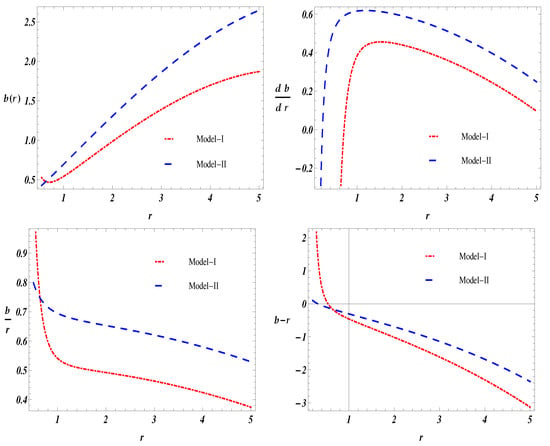
Figure 1.
Shows the structural properties of both the calculated shape functions with , , , , , and .
- Both the calculated shape functions are seen as positive with increasing behavior, this kind of behavior can be confirmed from the left penal of the first row of Figure 1. The positive behavior of both the shape function confirms physically compatibility of conformal symmetry with the linear equation of state and traceless fluid matter in the background of gravity.
- Flaring out condition, i.e., derivative of the obtained shape functions with respect to radial coordinate is seen less than one. The graphical behavior of can be seen from the right part of the first row of Figure 1.
- It is noted from the left part of the second row of Figure 1 that the flatness condition is satisfied for both investigated shape functions for model-I and model-II. The physical behavior for flatness condition, i.e., as is required for the wormhole existence.
- It is verified that the difference of calculated shape functions for both the models (I-II) with radial coordinate r, i.e., cut the x-axis and provide us the wormhole throat location. It is realized and for model-I and model-II respectively.
Now, all the energy conditions for traceless matter case are calculated as:
Now we are going to provide a detailed discussion regarding energy conditions for both models against both the calculated shape functions. Some important and required achievements from energy conditions under the current scenario are expressed as:
- It can be checked from Figure 2 that energy density remains positive for the negative values of parameter and it remains negative for the positive values of parameter .
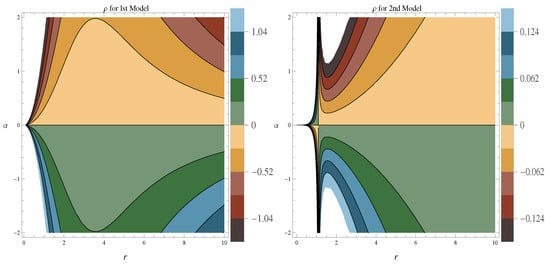 Figure 2. Shows the contribution of for both models with , , , , and .
Figure 2. Shows the contribution of for both models with , , , , and . - The graphical behavior of NEC, i.e., and is provided in Figure 3 and Figure 4 respectively. It is noticed from both figures that NEC is violated for model-I and model-II against the different ranges of parameter . The negative values of and confirm the presence of exotic matter, which is necessarily required for the existence of a viable wormhole.
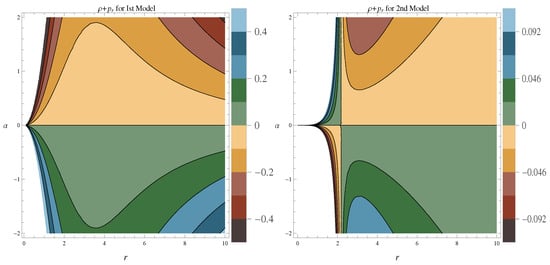 Figure 3. Shows the contribution of for both models with , , , , and .
Figure 3. Shows the contribution of for both models with , , , , and .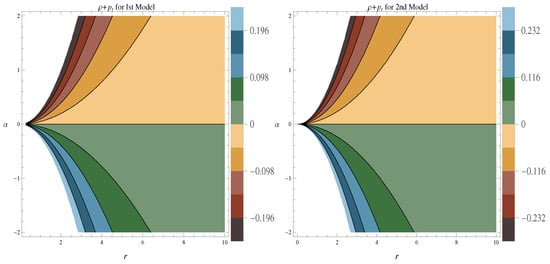 Figure 4. Shows the contribution of for both models with , , , , and .
Figure 4. Shows the contribution of for both models with , , , , and . - In response of the other energy conditions besides and , and also presented in Figure 5 and Figure 6 respectively. Both conditions and are observed violated for the different values of parameter .
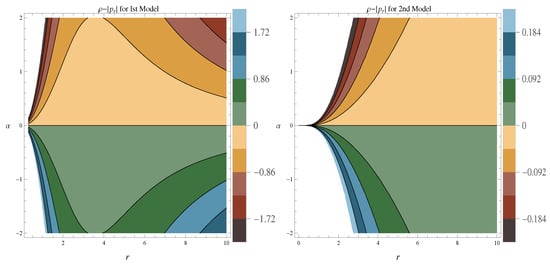 Figure 5. Shows the contribution of for both models with , , , , and .
Figure 5. Shows the contribution of for both models with , , , , and .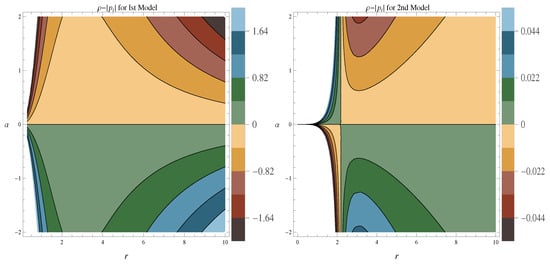 Figure 6. Shows the contribution of for both models with , , , , and .
Figure 6. Shows the contribution of for both models with , , , , and . - Strong energy condition, i.e., with graphical development is provide in Figure 7. It is interesting to mention that, is also violated in the current analysis against the different ranges of parameter under the effect of conformal symmetry within the linear equation of state and traceless fluid.
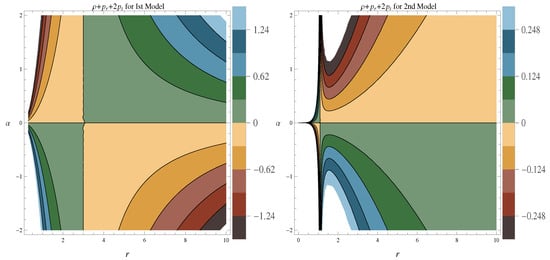 Figure 7. Shows the contribution of for both models with , , , , and .
Figure 7. Shows the contribution of for both models with , , , , and .
5. Final Remarks
We still do not know whether wormholes actually exist in the physical sense, but they are fascinating hypothetical space-time structures. The scientific community has prospered over the last few decades by exploring the nature of this geometric feature that is accepted mathematically. In this regard, the current study investigated tideless traversable wormholes in the framework of symmetric teleparallel gravity, specifically gravity. The following are a few of the investigation’s more intriguing and useful findings:
The left part in the first row of Figure 1 has confirmed that both of the calculated shape functions exhibit positive with an increasing trend. The conformal symmetry with the linear equation of state and the traceless fluid matter in the background of gravity has physically compatible, as shown by the positive behavior of both the shape function and shape function. The graphical development of , which has described the condition that is flaring out can be seen in the right portion of the first row of Figure 1. The physical required behavior for flatness condition, i.e., as has satisfied the wormhole existence. The difference of calculated shape functions for both models (I-II) with radial coordinate r, i.e., has been verified. It has depicted and for model-I and model-II respectively.
It is clear from Figure 2 that energy density is seen as positive for the negative values of parameter and it has shown negative for the positive values of parameter . The physical discussion of NEC, i.e., and has provided in Figure 3 and Figure 4 respectively for both models by left and right apart. It has been depicted from both the figures that NEC is violated for model-I and model-II within the different ranges of parameter through some regional plots. The negative trend of and has confirmed the presence of exotic matter, which has necessarily required for the existence of a viable and physically acceptable wormhole. Strong energy contribution, i.e., with graphical behaviour is provided in Figure 7. It is interesting to mention that, has also been violated in the current analysis against the different ranges of parameter under the effect of conformal symmetry within the linear equation of state and traceless fluid. It is worth noting that the current explored results in the background symmetric teleparallel gravity are physically viable. Consequently, it is abundantly clear from our analysis that the conformal symmetry satisfies all requirements for a traversable wormhole. With the aid of several other nonlinear models, it would be fascinating to investigate wormhole solutions in the symmetric teleparallel gravity.
Author Contributions
Conceptualization, M.J.; methodology, A.A.; formal analysis, A.B. resources, E.G.; data curation, A.C. and A.B.; investigation, M.J. and A.C.; writing—original draft, M.J., A.A., A.B., A.C. and E.G.; project administration, E.G. All authors made equal contributions to the work reported in this paper. All authors have read and agreed to the published version of the manuscript.
Funding
A.B. is supported by startup Grant No. ZC304021948, from Zhejiang Normal University and Grant No. ZC304022995, from Zhejiang Provincial Postdoctoral Science Foundation.
Data Availability Statement
There are no observational data related to this article. The necessary calculations and graphic discussion can be made available on request.
Acknowledgments
M.J. and A.B. are supported by the Postdoctoral fellowship and startup grants (No. ZC304022918 and No. ZC304021948, ZC304022995) funded by Zhejiang Normal University and Zhejiang Provincial Postdoctoral Science Foundation China, respectively. M.J. and A.B. are very thankful to Gao Xianlong from the Department of Physics, Zhejiang Normal University, for his kind support and help during this research.
Conflicts of Interest
The authors declare no conflict of interest.
References
- Flamm, L. Beiträge zur Einsteinschen Gravitationstheorie. Phys. Z. 1916, 17, 448. [Google Scholar]
- Einstein, A.; Rosen, N. The particle problem in the general theory of relativity. Phys. Rev. 1935, 48, 73. [Google Scholar] [CrossRef]
- Morris, M.S.; Thorne, K.S. Wormholes in spacetime and their use for interstellar travel: A tool for teaching general relativity. Am. J. Phys. 1988, 56, 395–412. [Google Scholar] [CrossRef]
- Visser, M. Lorentzian Wormholes: From Einstein to Hawking; American Institute of Physics: Woodbury, NY, USA, 1995. [Google Scholar]
- Gao, P.; Jafferis, D.L.; Wall, A.C. Traversable wormholes via a double trace deformation. J. High Energy Phys. 2017, 2017, 1–25. [Google Scholar] [CrossRef]
- Maldacena, J.; Qi, X.L. Eternal traversable wormhole. arXiv 2018, arXiv:1804.00491. [Google Scholar]
- Caceres, E.; Kundu, A.; Patra, A.K.; Shashi, S. A Killing vector treatment of multiboundary wormholes. J. High Energy Phys. 2020, 2020, 1–32. [Google Scholar] [CrossRef]
- Armendariz-Picon, C. On a class of stable, traversable Lorentzian wormholes in classical general relativity. Phys. Rev. D 2002, 65, 104010. [Google Scholar] [CrossRef]
- Nicolis, A.; Rattazzi, R.; Trincherini, E. Energy’s and amplitudes’ positivity. J. High Energy Phys. 2010, 2010, 1–22. [Google Scholar] [CrossRef]
- Visser, M. Traversable wormholes from surgically modified Schwarzschild spacetimes. Nucl. Phys. B 1989, 328, 203–212. [Google Scholar] [CrossRef]
- Kuhfittig, P.K. A wormhole with a special shape function. Am. J. Phys. 1999, 67, 125–126. [Google Scholar] [CrossRef]
- Boehmer, C.G.; Harko, T.; Lobo, F.S. Wormhole geometries in modified teleparallel gravity and the energy conditions. Phys. Rev. D 2012, 85, 044033. [Google Scholar] [CrossRef]
- Lobo, F.S.; Oliveira, M.A. Wormhole geometries in f(R) modified theories of gravity. Phys. Rev. D 2009, 80, 104012. [Google Scholar] [CrossRef]
- Capozziello, S.; Pincak, R.; Saridakis, E.N. Constructing superconductors by graphene Chern–Simons wormholes. Ann. Phys. 2018, 390, 303–333. [Google Scholar] [CrossRef]
- Capozziello, S.; Pinčák, R.; Bartoš, E. Chern-Simons current of left and right chiral superspace in graphene wormhole. Symmetry 2020, 12, 774. [Google Scholar] [CrossRef]
- Capozziello, S.; Francaviglia, M. Extended theories of gravity and their cosmological and astrophysical applications. Gen. Relativ. Gravit. 2008, 40, 357–420. [Google Scholar] [CrossRef]
- Capozziello, S.; Nojiri, S.i.; Odintsov, S.; Troisi, A. Cosmological viability of f(R)-gravity as an ideal fluid and its compatibility with a matter dominated phase. Phys. Lett. B 2006, 639, 135–143. [Google Scholar] [CrossRef]
- Capozziello, S.; Cardone, V.F.; Troisi, A. Reconciling dark energy models with f(R) theories. Phys. Rev. D 2005, 71, 043503. [Google Scholar] [CrossRef]
- Capozziello, S.; Stabile, A.; Troisi, A. Spherically symmetric solutions in f(R) gravity via the Noether symmetry approach. Class. Quantum Gravity 2007, 24, 2153. [Google Scholar] [CrossRef]
- Capozziello, S.; De Laurentis, M.; Odintsov, S.; Stabile, A. Hydrostatic equilibrium and stellar structure in f(R) gravity. Phys. Rev. D 2011, 83, 064004. [Google Scholar]
- Capozziello, S.; Luongo, O.; Mauro, L. Traversable wormholes with vanishing sound speed in f(R) gravity. Eur. Phys. J. Plus 2021, 136, 1–14. [Google Scholar]
- Capozziello, S.; Godani, N. Non-local gravity wormholes. Phys. Lett. B 2022, 835, 137572. [Google Scholar] [CrossRef]
- Jiménez, J.B.; Heisenberg, L.; Koivisto, T. Coincident general relativity. Phys. Rev. D 2018, 98, 044048. [Google Scholar] [CrossRef]
- Mandal, S.; Sahoo, P.; Santos, J.R. Energy conditions in f(Q) gravity. Phys. Rev. D 2020, 102, 024057. [Google Scholar] [CrossRef]
- Frusciante, N. Signatures of f(Q) gravity in cosmology. Phys. Rev. D 2021, 103, 044021. [Google Scholar] [CrossRef]
- Zhao, D. Covariant formulation of f(Q) theory. Eur. Phys. J. C 2022, 82, 303. [Google Scholar] [CrossRef]
- Soudi, I.; Farrugia, G.; Said, J.L.; Gakis, V.; Saridakis, E.N. Polarization of gravitational waves in symmetric teleparallel theories of gravity and their modifications. Phys. Rev. D 2019, 100, 044008. [Google Scholar] [CrossRef]
- Lazkoz, R.; Lobo, F.S.; Ortiz-Baños, M.; Salzano, V. Observational constraints of f(Q) gravity. Phys. Rev. D 2019, 100, 104027. [Google Scholar] [CrossRef]
- Ayuso, I.; Lazkoz, R.; Salzano, V. Observational constraints on cosmological solutions of f(Q) theories. Phys. Rev. D 2021, 103, 063505. [Google Scholar] [CrossRef]
- Barros, B.J.; Barreiro, T.; Koivisto, T.; Nunes, N.J. Testing F(Q) gravity with redshift space distortions. Phys. Dark Universe 2020, 30, 100616. [Google Scholar] [CrossRef]
- Anagnostopoulos, F.K.; Basilakos, S.; Saridakis, E.N. First evidence that non-metricity f(Q) gravity could challenge ΛCDM. Phys. Lett. B 2021, 822, 136634. [Google Scholar] [CrossRef]
- Harko, T.; Koivisto, T.S.; Lobo, F.S.; Olmo, G.J.; Rubiera-Garcia, D. Coupling matter in modified Q gravity. Phys. Rev. D 2018, 98, 084043. [Google Scholar] [CrossRef]
- Khyllep, W.; Paliathanasis, A.; Dutta, J. Cosmological solutions and growth index of matter perturbations in f(Q) gravity. Phys. Rev. D 2021, 103, 103521. [Google Scholar] [CrossRef]
- Solanki, R.; De, A.; Mandal, S.; Sahoo, P. Accelerating expansion of the universe in modified symmetric teleparallel gravity. Phys. Dark Universe 2022, 36, 101053. [Google Scholar] [CrossRef]
- Esculpi, M.; Aloma, E. Conformal anisotropic relativistic charged fluid spheres with a linear equation of state. Eur. Phys. J. C 2010, 67, 521–532. [Google Scholar] [CrossRef]
- Solanki, R.; Sahoo, P.K. Statefinder Analysis of Symmetric Teleparallel Cosmology. Ann. Der Phys. 2022, 534, 2200076. [Google Scholar] [CrossRef]
- D’Ambrosio, F.; Fell, S.D.; Heisenberg, L.; Kuhn, S. Black holes in f(Q) gravity. Phys. Rev. D 2022, 105, 024042. [Google Scholar] [CrossRef]
- Lin, R.H.; Zhai, X.H. Spherically symmetric configuration in f(Q) gravity. Phys. Rev. D 2021, 103, 124001. [Google Scholar] [CrossRef]
- Wang, W.; Chen, H.; Katsuragawa, T. Static and spherically symmetric solutions in f(Q) gravity. Phys. Rev. D 2022, 105, 024060. [Google Scholar] [CrossRef]
- Mustafa, G.; Hassan, Z.; Moraes, P.; Sahoo, P. Wormhole solutions in symmetric teleparallel gravity. Phys. Lett. B 2021, 821, 136612. [Google Scholar] [CrossRef]
- Calzá, M.; Sebastiani, L. A class of static spherically symmetric solutions in f(Q)-gravity. Eur. Phys. J. C 2023, 83, 1–9. [Google Scholar] [CrossRef]
- Mustafa, G.; Hassan, Z.; Sahoo, P. Traversable wormhole inspired by non-commutative geometries in f(Q) gravity with conformal symmetry. Ann. Phys. 2022, 437, 168751. [Google Scholar] [CrossRef]
- Sokoliuk, O.; Hassan, Z.; Sahoo, P.K.; Baransky, A. Traversable wormholes with charge and non-commutative geometry in the f(Q) gravity. Ann. Phys. 2022, 443, 168968. [Google Scholar] [CrossRef]
- Mandal, S.; Mustafa, G.; Hassan, Z.; Sahoo, P. A study of anisotropic spheres in f(Q) gravity with quintessence field. Phys. Dark Universe 2022, 35, 100934. [Google Scholar] [CrossRef]
- Bhar, P.; Rahaman, F.; Ray, S.; Chatterjee, V. Possibility of higher-dimensional anisotropic compact star. Eur. Phys. J. C 2015, 75, 190. [Google Scholar] [CrossRef]
- Das, A.; Rahaman, F.; Guha, B.; Ray, S. Relativistic compact stars in f(T) gravity admitting conformal motion. Astrophys. Space Sci. 2015, 358, 36. [Google Scholar] [CrossRef]
- Mustafa, G.; Abbas, G.; Xia, T. Wormhole solutions in F (T, TG) gravity under Gaussian and Lorentzian non-commutative distributions with conformal motions. Chin. J. Phys. 2019, 60, 362–378. [Google Scholar] [CrossRef]
- Mustafa, G.; Waheed, S.; Zubair, M.; Xia, T.C. Non-commutative wormholes exhibiting conformal motion in Rastall gravity. Chin. J. Phys. 2020, 65, 163–176. [Google Scholar] [CrossRef]
- Mustafa, G.; Waheed, S.; Zubair, M.; Xia, T. Gaussian distributed wormholes exhibiting conformal motion in f(T) gravity. Int. J. Geom. Methods Mod. Phys. 2019, 16, 1950143. [Google Scholar] [CrossRef]
- Mustafa, G.; Maurya, S.; Hussain, I. Relativistic Wormholes in Extended Teleparallel Gravity with Minimal Matter Coupling. Fortschritte der Physik 2023, 2200119. [Google Scholar] [CrossRef]
- Jiménez, J.; Heisenberg, L.; Koivisto, T. The Geometrical Trinity of Gravity. Universe 2019, 5, 173. [Google Scholar] [CrossRef]
- Saiedi, H.; Nasr Esfahani, B. Time-dependent wormhole solutions of f(R) theory of gravity and energy conditions. Mod. Phys. Lett. A 2011, 26, 1211–1219. [Google Scholar] [CrossRef]
- Sharif, M.; Rani, S. f(T) gravity and static wormhole solutions. Mod. Phys. Lett. A 2014, 29, 1450137. [Google Scholar] [CrossRef]
Disclaimer/Publisher’s Note: The statements, opinions and data contained in all publications are solely those of the individual author(s) and contributor(s) and not of MDPI and/or the editor(s). MDPI and/or the editor(s) disclaim responsibility for any injury to people or property resulting from any ideas, methods, instructions or products referred to in the content. |
© 2023 by the authors. Licensee MDPI, Basel, Switzerland. This article is an open access article distributed under the terms and conditions of the Creative Commons Attribution (CC BY) license (https://creativecommons.org/licenses/by/4.0/).